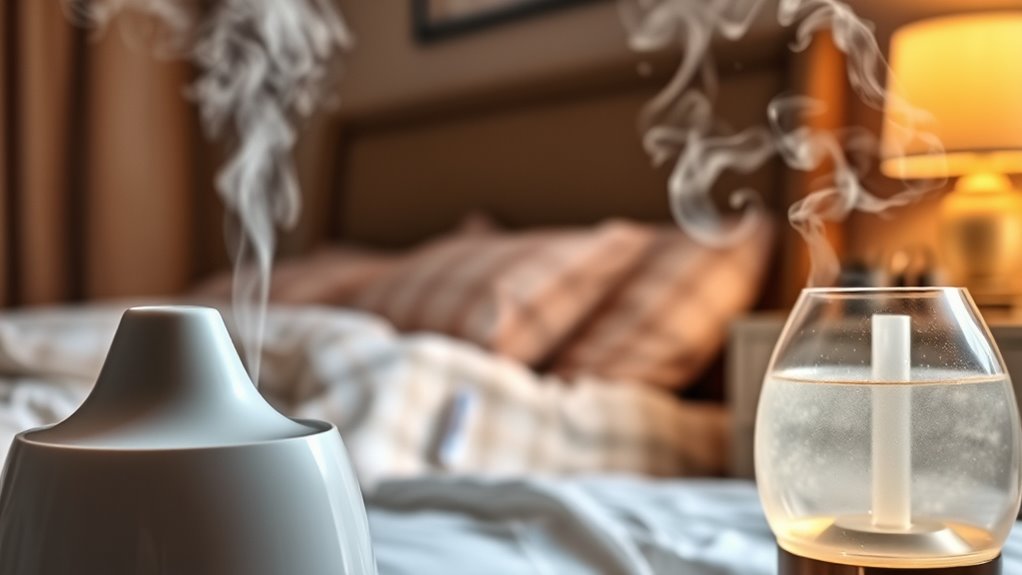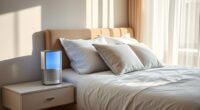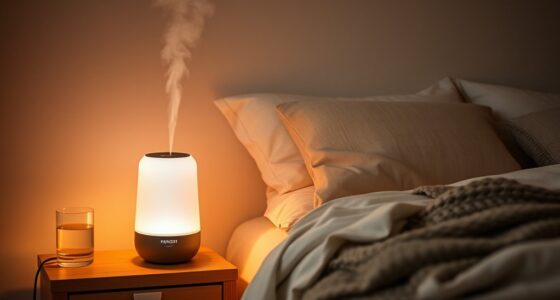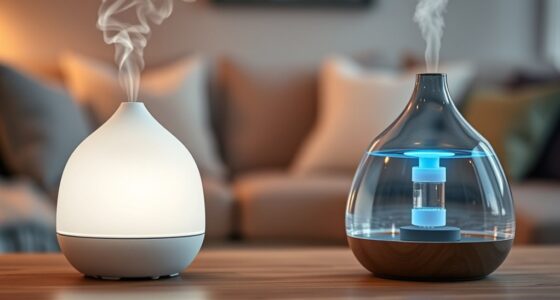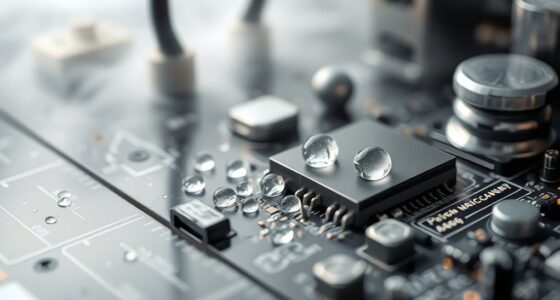If you’re choosing between a humidifier and a vaporizer for cold and flu season, consider safety and effectiveness. Vaporizers boil water to produce steam, killing germs and providing quick relief, but they can pose burn risks. Humidifiers add moisture without heat, making them safer, especially for children and sensitive individuals. Both can improve air quality, but understanding their differences helps you pick the best option. Keep exploring to find the perfect fit for your home and health.
Key Takeaways
- Vaporizers kill germs effectively with boiling water, offering a safer option during cold and flu season.
- Cool mist humidifiers are safer for children and sensitive individuals, reducing burn risks.
- Both devices improve indoor humidity, easing respiratory symptoms and preventing dryness-related issues.
- Regular cleaning is essential for both to prevent mold and bacteria buildup, ensuring safe and effective use.
- Vaporizers tend to be more energy-consuming and may pose burn hazards, while humidifiers are generally safer and easier to maintain.
How Do Humidifiers and Vaporizers Work?

Humidifiers and vaporizers both add moisture to the air, but they do so in different ways. When you use a humidifier, it releases a fine mist of water into the room, creating a humid atmosphere. This humidifier mist helps soothe dry skin, throat, and nasal passages. Vaporizers work by heating water to produce vapor steam, which then disperses into the air. This steam can help relieve congestion and cold symptoms more quickly. While humidifiers often operate silently and maintain a cooler mist, vaporizers generate hot vapor steam that can be more effective at killing germs. Both devices aim to increase indoor humidity, but their mechanisms—humidifier mist versus vaporizer steam—are distinct, influencing their suitability for different needs. Additionally, vaporizer units may pose a burn risk, so caution is advised when using hot steam devices.
Different Types of Humidifiers and Vaporizers

There are several types of humidifiers and vaporizers to contemplate, each with unique features. Ultrasonic models use high-frequency vibrations, while evaporative units rely on a fan and wick filter. You’ll also find warm mist and cool mist options, as well as portable devices versus whole-house systems, depending on your needs. Additionally, understanding family dynamics can help you choose a model that best fits your household’s environment.
Ultrasonic vs. Evaporative
When choosing between ultrasonic and evaporative humidifiers or vaporizers, understanding their core differences can help you make an informed decision. Ultrasonic devices use high-frequency vibrations to produce a cool mist, which adds moisture quickly without much noise. They tend to be quieter and more energy-efficient, but they can disperse minerals from tap water, potentially affecting air quality. Evaporative units use a wick filter and a fan to evaporate water naturally, helping to regulate humidity levels and reduce airborne minerals. They are less likely to release minerals into the air, which can benefit air quality. Your choice depends on your environment: ultrasonic models are great for quiet operation, while evaporative units provide more natural humidity control and cleaner air. Additionally, some self watering plant pots incorporate features that maintain optimal moisture levels, which can be beneficial in environments with fluctuating humidity.
Warm Mist vs. Cool Mist
Choosing between warm mist and cool mist humidifiers depends on your specific needs and preferences. Warm mist models heat water to create vapor, offering benefits like better humidifier capacity and the ability to reduce bacteria through higher vaporizer temperature. Cool mist humidifiers release room-temperature vapor, which can be safer around children and pets. Here are key differences:
- Humidifier capacity: Warm mist units often have smaller tanks but produce more concentrated vapor, while cool mist models typically hold larger volumes for longer operation.
- Vaporizer temperature: Warm mist heats water, killing germs, but may pose a burn risk. Cool mist stays at room temperature, reducing safety concerns.
- Maintenance: Warm mist requires regular cleaning to prevent mineral buildup, whereas cool mist needs frequent filter replacements.
- Technology differences: The technology used in each type affects their performance, noise levels, and maintenance requirements.
Portable vs. Whole-House
Portable humidifiers and vaporizers are designed for individual room use, offering convenience and flexibility. These portable options are easy to move from one space to another, making them ideal for targeted humidification. They’re perfect if you only need to address dryness in specific areas or want something simple to set up. Whole-house systems, on the other hand, are installed directly into your home’s HVAC system, providing consistent humidity throughout your entire house. While they require a larger upfront investment and professional installation, whole-house systems ensure even moisture distribution, reducing dry air issues across multiple rooms. Your choice depends on your needs: portable options suit temporary or localized relief, while whole-house systems are better for extensive, long-term humidity control. Additionally, humidifier and vaporizer models vary in features such as capacity and ease of use, allowing you to select the best option for your specific environment.
Benefits of Using a Humidifier During Cold and Flu Season
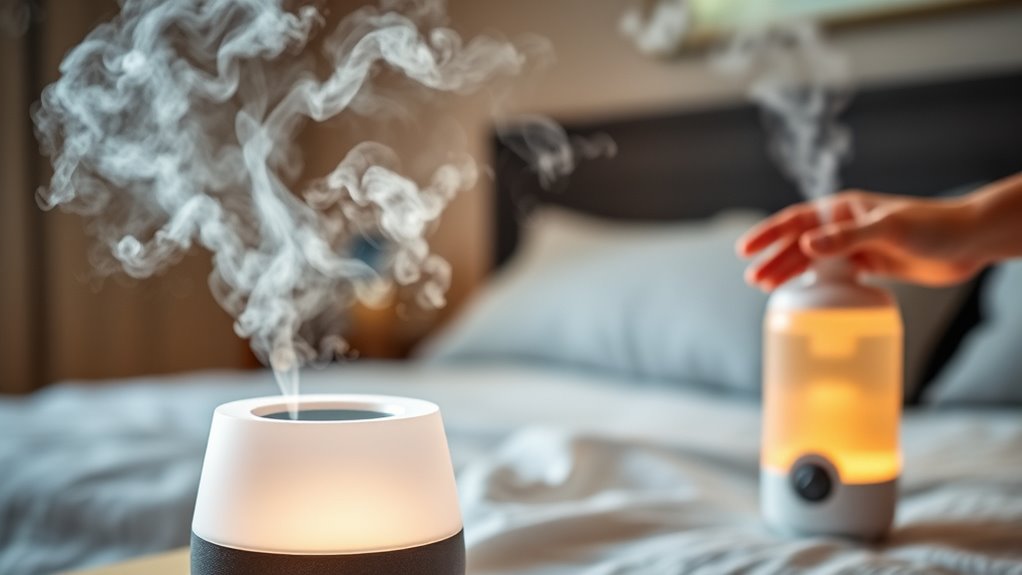
During cold and flu season, using a humidifier can substantially improve your comfort and health. It boosts air quality, making your environment less dry and more comfortable. Additionally, it provides breathing relief by keeping nasal passages moist and reducing irritation. Here are three key benefits:
- Enhances air quality, preventing dryness that worsens respiratory issues.
- Eases breathing, helping you breathe more comfortably, especially at night.
- Reduces the spread of germs by maintaining ideal humidity levels, which can inhibit virus survival.
- Proper humidity levels supported by humidifiers and vaporizers can also promote overall respiratory health, reducing the likelihood of infections and irritation.
Advantages of Vaporizers for Cold and Flu Relief
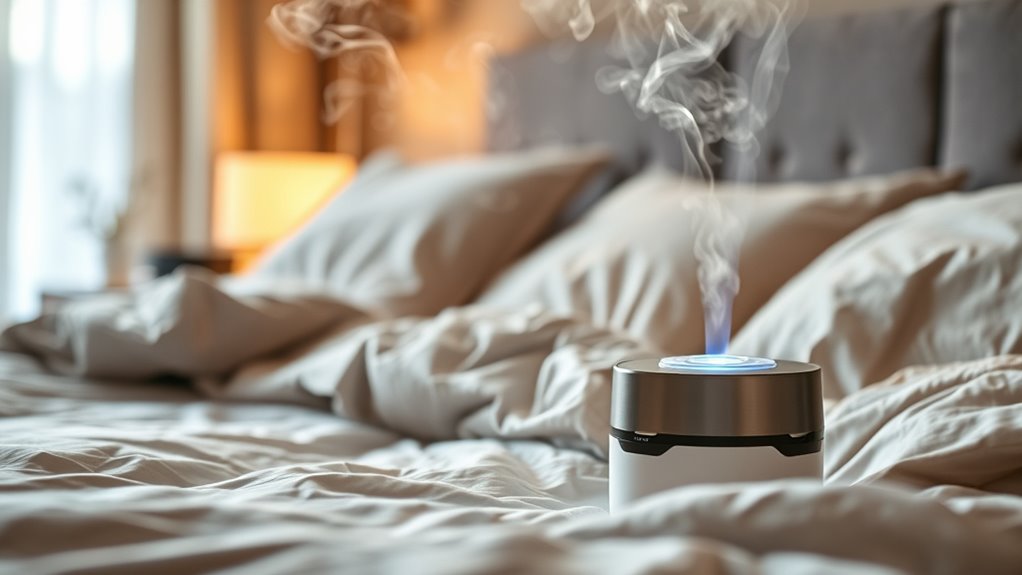
Vaporizers offer a targeted way to soothe cold and flu symptoms by producing hot steam that can directly relieve congestion. The vaporizer advantages include delivering moist heat that loosens mucus, making it easier to breathe. Unlike humidifier benefits, which gently add moisture to the air, vaporizers provide direct steam, providing more immediate relief for stuffy noses and sore throats. The high temperature can also kill germs and bacteria, reducing the risk of reinfection. Additionally, vaporizers are portable and easy to use, making them convenient during illness. Overall, the benefits of using a vaporizer include rapid symptom relief and the ability to deliver concentrated moist heat, making it an effective tool for managing cold and flu discomfort. Understanding the importance of emotional support can help individuals and families cope better during illness episodes.
Potential Risks and Safety Considerations
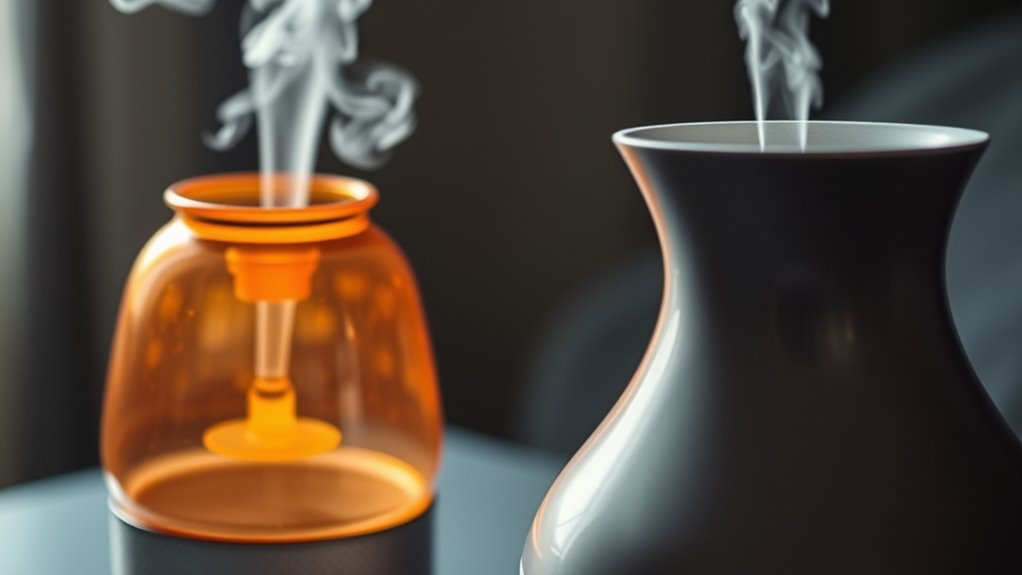
While vaporizers can provide quick relief for cold and flu symptoms, they also pose certain risks if not used properly. Poor usage can negatively impact your air quality and increase allergy triggers. Here are three safety considerations:
- Overhumidification – Excess moisture can promote mold growth and dust mites, worsening allergy symptoms.
- Water contamination – Using unclean water can disperse bacteria or mold into the air, risking respiratory issues.
- Temperature hazards – Boiling water can cause burns if the device is knocked over or mishandled.
- Using natural materials in device components can help reduce the buildup of mold and bacteria, promoting a healthier environment.
To stay safe, always use distilled water, keep the device clean, and monitor humidity levels. Proper use minimizes risks related to air quality deterioration and allergy triggers, ensuring a safer environment during cold and flu season.
Maintenance and Cleaning Requirements

Regular maintenance and cleaning are essential to keep your vaporizer functioning safely and efficiently. You should replace the filter regularly to prevent mold and bacteria buildup, which can compromise air quality. Check the manufacturer’s recommendations for filter replacement intervals, typically every 1 to 3 months. Cleaning frequency depends on usage, but it’s best to clean your vaporizer at least once a week. Use a mild detergent and warm water to scrub all removable parts, including the tank and lid. Avoid harsh chemicals that could damage components or release harmful residues. Proper cleaning prevents mineral deposits and mold growth, ensuring your device operates smoothly and safely. Staying consistent with filter replacement and cleaning is key to maintaining a healthy environment during cold and flu season. Additionally, be aware that air quality can be impacted by stagnant air and dirty filters, so maintaining a clean device helps improve overall indoor air conditions.
Noise Levels and Ease of Use

You’ll notice that vaporizers tend to operate more quietly than humidifiers, making them better for bedrooms or quiet spaces. Setting up and using each device varies—vaporizers are often simpler, but some humidifiers have more features that require extra effort. When it comes to cleaning, vaporizers usually need less maintenance, while humidifiers can require more frequent cleaning to prevent buildup. Additionally, choosing the right device can depend on the noise levels to ensure a restful environment.
Operational Noise Differences
Humidifiers generally operate more quietly than vaporizers, making them a better choice if you need minimal noise during sleep or work. Their quieter operation creates gentle white noise that can actually promote better sleep without causing sleep disruption. Vaporizers tend to produce more noise due to boiling water, which can interfere with rest. To compare:
- Humidifiers emit a soft hum, often blending into white noise, ideal for overnight use.
- Vaporizers generate louder boiling sounds, which may disturb sleep.
- Both devices are easy to operate, but humidifiers usually require less attention to noise levels.
- Understanding the noise levels associated with each device can help you choose the best option for your environment.
If noise sensitivity is your concern, especially during sleep, a humidifier’s quieter operation helps maintain a peaceful environment, reducing sleep disruptions during cold and flu season.
Ease of Setup and Use
Both humidifiers and vaporizers are straightforward to set up and operate, but they differ in ease of use and noise levels. Humidifiers are typically quieter and easier to maintain, requiring regular humidifier maintenance to prevent mold. Vaporizers often produce more noise but are simple to use, with safety features like automatic shut-off for vaporizer safety. Additionally, selecting the right device can depend on device safety considerations and personal preferences.
Maintenance and Cleaning Effort
While both devices aim to improve air quality, they differ considerably in maintenance and noise levels. Vaporizer maintenance mainly involves regular water tank cleaning to prevent mineral buildup and bacterial growth. In contrast, humidifiers often require filter replacement every few months, adding an extra step. Regarding noise levels, vaporizers tend to operate quietly, while some humidifiers can be louder during use. To keep your device running smoothly, consider these points:
- Schedule water tank cleaning weekly for vaporizers.
- Replace filters in humidifiers as recommended by the manufacturer.
- Choose a model with low noise if you prefer quiet operation during sleep.
- Selecting a textile-friendly device can reduce the need for frequent cleaning and maintenance.
Both require effort, but vaporizers generally need less ongoing maintenance beyond water cleaning, while humidifiers demand attention to filter replacement.
Cost and Energy Consumption
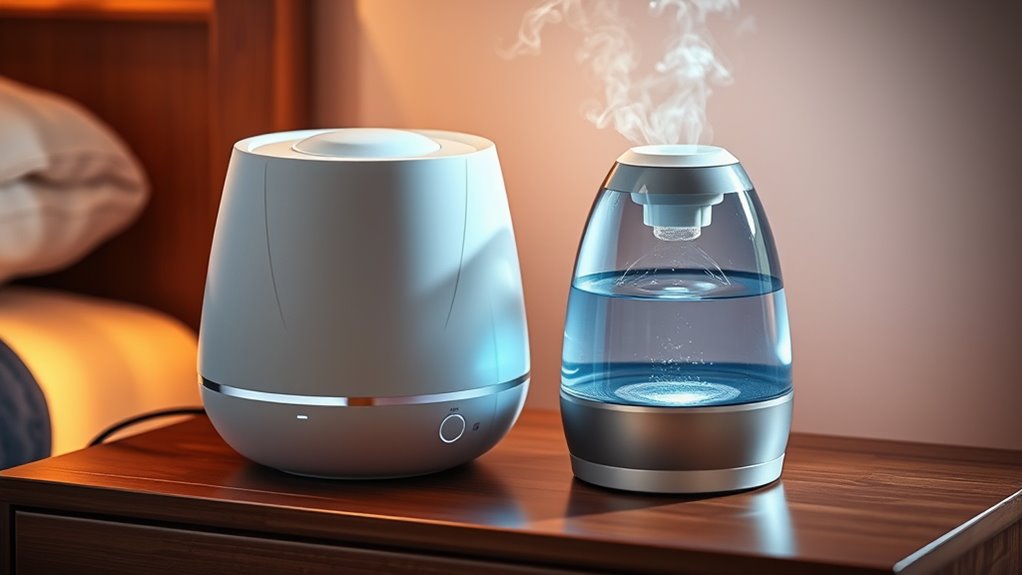
When comparing the cost and energy consumption of humidifiers and vaporizers, you’ll find that vaporizers generally require more energy due to their heating element, leading to higher electricity bills over time. Vaporizers tend to be less energy-efficient but can improve air quality quickly since they add moisture through boiling water. Humidifiers, on the other hand, usually consume less power, making them more budget-friendly in the long run. Additionally, device durability plays a role; vaporizers often have more parts exposed to heat, which can affect longevity if not maintained properly. While vaporizers may cost more to operate, they might last longer if well cared for. Furthermore, the energy efficiency of a device influences ongoing operational costs and environmental impact. Overall, your choice depends on balancing initial costs, ongoing energy expenses, and how durable you need your device to be.
Which Device Is Better for Children and Sensitive Individuals?

Choosing the right humidification device for children and sensitive individuals requires careful consideration of safety and health factors. You want to guarantee child safety and accommodate sensitive skin. Vaporizers are often preferred because they boil water, killing bacteria and mold before releasing steam, reducing allergy risks. Humidifiers, especially ultrasonic models, can emit fine particles that may irritate sensitive skin or cause respiratory issues if not properly maintained.
Consider these points:
- Vaporizers minimize bacteria and mold concerns, making them safer for children.
- Ultrasonic humidifiers may require regular cleaning to prevent mineral dust.
- Both devices should be used with clean, distilled water to assure safety and reduce irritation.
Your choice depends on prioritizing safety and minimizing skin or respiratory sensitivities.
Making the Right Choice for Your Home and Health

When choosing between a humidifier and vaporizer, you need to contemplate how they impact your health, safety, and daily routine. Think about which option offers better benefits, is easier to maintain, and fits your budget. Making the right choice helps you improve your home environment while keeping your family safe and comfortable. Additionally, understanding the material options of each device can influence heat retention and safety considerations.
Health Benefits Comparison
Humidifiers and vaporizers both add moisture to the air, but their health benefits can differ markedly. Your choice affects your overall well-being.
- Humidifier health benefits include reducing dry skin, easing respiratory issues, and preventing nosebleeds. They maintain humidity levels that support skin and respiratory health without adding medication or heat.
- Vaporizer health benefits involve soothing sore throats, alleviating congestion, and providing warmth that can help fight colds. Because vaporizers produce hot steam, they can kill germs, making them beneficial during illness.
- Keep in mind that humidifier health is generally safer for everyday use, while vaporizer health offers added comfort during cold and flu season. Your decision should balance these benefits with your personal health needs.
- When choosing between the two, consider the effectiveness of filtration and sterilization to ensure optimal air quality and safety during use.
Safety and Maintenance
While both humidifiers and vaporizers can improve air quality, their safety and maintenance needs differ greatly. You must regularly clean your device to prevent mold, bacteria, and mineral buildup, which can compromise air quality. Vaporizers, which boil water, reduce bacterial growth but pose burn risks if mishandled. Humidifiers are generally safer but require frequent cleaning to prevent mold. Energy efficiency varies; vaporizers use more power due to boiling water, while humidifiers often consume less. Consider the table below for quick reference:
| Aspect | Humidifier | Vaporizer |
|---|---|---|
| Safety | Safer; no boiling water | Risk of burns |
| Maintenance | Regular cleaning needed | Regular cleaning needed |
| Air quality | Prevents mold if cleaned | Reduces bacteria with boiling |
| Energy efficiency | More efficient | Less efficient |
| Usage safety | Low risk | Higher risk if mishandled |
Additionally, understanding the air quality benefits of each device can help you make a more informed decision.
Cost and Convenience
Choosing between a humidifier and a vaporizer often depends on your budget and how convenient you want the device to be. Both offer different levels of humidity control and device affordability, impacting your daily use.
Consider these factors:
- Initial Cost: Vaporizers are usually more affordable upfront but may require more maintenance.
- Operating Expenses: Humidifiers often need replacement filters, increasing ongoing costs.
- Convenience: Humidifiers are generally easier to clean and maintain, making them more convenient for regular use.
- Effective Humidity Control can be achieved more precisely with humidifiers due to their adjustable settings.
If you prioritize precise humidity control and less maintenance, a humidifier might be better. If affordability and portability are key, a vaporizer could be the right choice. Balance these aspects to find the best fit for your home and health needs.
Frequently Asked Questions
Can Humidifiers or Vaporizers Help With Allergies or Asthma Symptoms?
You might wonder if humidifiers or vaporizers can help with allergy or asthma symptoms. They improve air quality by adding moisture, which can soothe dry airways and promote breathing relief. However, it’s important to maintain clean devices to prevent mold or bacteria buildup. Using them correctly can make a noticeable difference in reducing irritation and improving your overall comfort, especially during allergy season or when asthma triggers are present.
Are There Specific Medications That Can Be Added to Vaporizers?
You can add certain medications to vaporizers, but you need to verify medication compatibility first. Some vaporizer additives, like inhalants or medicinal oils, are safe and can help with respiratory issues. However, not all medications are suitable, and improper use could cause harm. Always consult your healthcare provider or read manufacturer guidelines before adding any medication to your vaporizer to ensure safe and effective use.
How Do I Prevent Mold and Bacteria Growth in Humidifiers?
Imagine you’re a wizard, and your humidifier’s your magical vessel. To prevent mold and bacteria, stick to regular maintenance routines—clean it weekly with soap and water. Use antimicrobial solutions approved for humidifiers to keep germs at bay. Always empty, dry, and store it properly when not in use. This proactive approach keeps your space healthy and safe, making your humidifier a true magic wand against indoor air pollutants.
What Are the Environmental Impacts of Using Each Device?
You should consider the environmental impacts of each device, like energy consumption and plastic waste. Humidifiers generally use more electricity, increasing your carbon footprint, while vaporizers often contain more plastic components that contribute to waste. Opt for energy-efficient models and reusable parts to reduce environmental harm. By choosing wisely, you help lower energy use and minimize plastic waste, making your home more eco-friendly during cold and flu season.
Can Using a Humidifier or Vaporizer Worsen Respiratory Issues?
Using a humidifier or vaporizer can worsen respiratory issues if device safety isn’t maintained. Poor maintenance routines, like not cleaning regularly, can lead to mold, bacteria, or mineral buildup, which exacerbate breathing problems. Always follow manufacturer instructions, clean your device often, and use distilled water to reduce risks. Proper care helps guarantee the device benefits your health without causing additional respiratory discomfort.
Conclusion
Choosing between a humidifier and a vaporizer depends on your needs, but remember, the right device can be your best ally during cold and flu season. Think of it as finding the perfect puzzle piece to keep your home comfortable and your family healthy. Weigh safety, ease of use, and your specific concerns, and you’ll find the ideal solution that helps you breathe easier—like a gust of fresh air in a storm.
